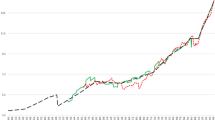
Overview
- Sheds a definitive light on the long run economic performance of Spain to date
- Constructs estimates for production, private and public consumption, and sectoral output for Spain
- Critically discusses existing estimates and compares with other European economics
- Includes supplementary material: sn.pub/extras
- Includes supplementary material: sn.pub/extras
Part of the book series: Palgrave Studies in Economic History (PEHS)
Buy print copy
Tax calculation will be finalised at checkout
About this book
This book is open access under a CC BY 4.0 license.
This text offers a comprehensive and nuanced view of the economic development of Spain since 1850. It provides a new set of historical GDP estimates for Spain from the demand and supply sides, and presents a reconstruction of production and expenditure series for the century prior to the introduction of modern national accounts. The author splices available national accounts sets over the period 1958–2015 through interpolation, as an alternative to conventional retropolation. The resulting national accounts series are linked to the historical estimates providing yearly series for GDP and its components since 1850. On the basis of new population estimates, the author derives GDP per head, decomposed into labour productivity and the amount of work per person, and placed into international perspective.
With theoretical reasoning and historiographical implications, Prados de la Escosura provides a useful methodological reference work for anyone interested in national accounting.
Open Access has been made possible thanks to Fundación Rafael del Pino's generous support.
You can find the full dataset here: http://espacioinvestiga.org/bbdd-chne/?lang=en
‘This book stands among the classics for the Kuznetian paradigm in empirical economics. This is the definitive study of Spain's transition to a modern economy.’
—Patrick Karl O'Brien, Emeritus Fellow at St. Antony’s College, the University of Oxford, UK, and Professor Emeritus of Global Economic History at the London School of Economics and Political Science, UK
‘The definitive account of Spanish economic growth since 1850, based firmly on a magisterial reconstruction of that country’s national accounts and an unrivalled knowledge of both Spanish and global economic history of the period.’
—Stephen Broadberry, Professor of Economic History at Nuffield College, the University of Oxford, UK
Similar content being viewed by others
Keywords
Table of contents (11 chapters)
-
Front Matter
-
Back Matter
Authors and Affiliations
About the author
Leandro Prados de la Escosura is Professor of Economic History at Carlos III University in Madrid, Spain, and Honorary Maddison Chair in the Faculty of Economics and Business, at the University of Groningen, the Netherlands. He is also Research Fellow at the Centre for Economic Policy Research (CEPR), UK, Research Associate at the Centre for Competitive Advantage in the Global Economy (CAGE), UK, and Corresponding Fellow of the Royal Academy of History, Spain. He has published articles and books on long-run growth and retardation in Spain, the economic consequences of Latin American independence, the costs and benefits of European Imperialism, and British Exceptionalism at the time of the Industrial Revolution.
Bibliographic Information
Book Title: Spanish Economic Growth, 1850–2015
Authors: Leandro Prados de la Escosura
Series Title: Palgrave Studies in Economic History
DOI: https://doi.org/10.1007/978-3-319-58042-5
Publisher: Palgrave Macmillan Cham
eBook Packages: Economics and Finance, Economics and Finance (R0)
Copyright Information: The Editor(s) (if applicable) and The Author(s) 2017
Hardcover ISBN: 978-3-319-58041-8Published: 19 September 2017
Softcover ISBN: 978-3-319-86308-5Published: 10 August 2018
eBook ISBN: 978-3-319-58042-5Published: 04 September 2017
Series ISSN: 2662-6497
Series E-ISSN: 2662-6500
Edition Number: 1
Number of Pages: XXIV, 383
Number of Illustrations: 36 b/w illustrations
Topics: Economic History, European Economics, Economic Growth, Development Economics, Labor Economics, Agricultural Economics



